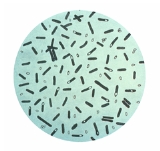
Clostridium botulinum
Overview
Neurotoxin
A neurotoxin is a toxin that acts specifically on nerve cells , usually by interacting with membrane proteins such as ion channels. Some sources are more general, and define the effect of neurotoxins as occurring at nerve tissue...
s, subdivided in types A-G, that cause the flaccid muscular paralysis
Paralysis
Paralysis is loss of muscle function for one or more muscles. Paralysis can be accompanied by a loss of feeling in the affected area if there is sensory damage as well as motor. A study conducted by the Christopher & Dana Reeve Foundation, suggests that about 1 in 50 people have been diagnosed...
seen in botulism
Botulism
Botulism also known as botulinus intoxication is a rare but serious paralytic illness caused by botulinum toxin which is metabolic waste produced under anaerobic conditions by the bacterium Clostridium botulinum, and affecting a wide range of mammals, birds and fish...
. It is also the main paralytic agent in botox. C. botulinum is an anaerobic
Anaerobic organism
An anaerobic organism or anaerobe is any organism that does not require oxygen for growth. It could possibly react negatively and may even die if oxygen is present...
spore-former, which produces oval, subterminal endospores and is commonly found in soil
Soil
Soil is a natural body consisting of layers of mineral constituents of variable thicknesses, which differ from the parent materials in their morphological, physical, chemical, and mineralogical characteristics...
. In addition it produces two ADP-ribosyltransferases: C2 and Clostridium botulinum C3 toxin
Clostridium botulinum C3 toxin
Clostridium botulinum C3 exoenzyme is a toxin that causes the ADP-ribosylate of Rho-like proteins. Many bacterial toxins nucleotide-binding modify by ADP-ribosylation proteins involved in essential cell functions....
.
Unanswered Questions

